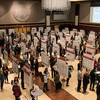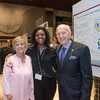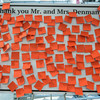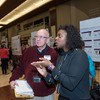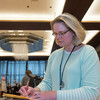Page content

It’s an annual trek that’s become a rite of passage for hundreds of Ohio State students. They descend upon the event space wearing their best suits, clutching long plastic tubes in their arms. What’s inside represents hours and hours of hard work – in some cases years of commitment – which they’ll soon reveal to the public.
Inside the Ohio Union’s Archie M. Griffin Grand Ballroom, they carefully pin their posters at their designated boards, forming rows and rows of displays that showcase a wide variety of research projects. One can walk down the crowded aisles and learn about student research involving diverse topics such as bloodstream infections or the plight of urban dairy farmers in Uganda. The student researchers stand anxiously as they wait for the judges to pepper them with questions about their methods, their goals and their results.
Mikafui Dzotsi has been here before – it’s her second time presenting at Ohio State’s Denman Forum, which has grown into one of the largest undergraduate research forums in the country. Today she stands alongside nearly 800 other students who’ve come here to showcase their hard work.
“I feel like it’s a high point to my time here at Ohio State,” said Dzotsi, a public health major who became interested in preventive medicine during a high school service trip to Nicaragua that involved working in poor communities.
“Plus, both of my parents come from developing countries. My dad is from Ghana and my mom is from Dominica. That also drove my interest in preventive medicine – trying to find solutions to things before they got really bad.”
Dzotsi’s research focused on university protocols for meningitis vaccines. She traveled abroad, interviewed public health officials and combed through pages and pages of data. Now, at the Denman Forum, she proudly displays her project that’s been two years in the making.
“Getting from that point when I started to today, and seeing how the results can be put into action and could actually affect policy, it’s really cool.”
The first Denman Forum in 1996 had 60 participants. Today there are 791. It’s hosted by the Office of Undergraduate Research and Creative Inquiry, which approves the submissions and organizes them into dozens of categories. Each student will be assessed by at least two judges.
Dzotsi spent the night before practicing in her off-campus apartment, recruiting her six roommates to act as judges.
“Three of my roommates are architecture majors, so they had no background in public health,” she said. “It was good practice because you want to convey all your points and get them across easily and quickly, but also in a way that anyone you’re presenting to can understand.”
A lasting legacy
 Rick and Marte Denman pose next to a sign marking the latest renewal of the Denman Undergraduate Research Forum.
Rick and Marte Denman pose next to a sign marking the latest renewal of the Denman Undergraduate Research Forum.Nearly five hours into the forum, a constant hum filled the Ohio Union’s main ballroom, where hundreds of students were giving presentations next to displayed poster boards depicting their research.
A couple beaming with pride ambled through the beehive of activity.
“This is our legacy,” Rick Denman said.
Denman, 87, and his wife Marte, 82, traveled nearly 2,300 miles from their home in Rancho Sante Fe, California, to attend the forum that bears their name on the campus where the Ohio natives met on a blind date during his senior year.
“I look forward to this program every year,” said Rick Denman, a 1957 graduate. “It’s stimulating. The excitement and enthusiasm of the students rubs off.”
Said Marte Denman: “We call this our psychic income.”
Rick Denman, without a name tag but wearing his Ohio State class ring, and his wife of 61 years stopped to talk with students about their projects throughout the second three-hour session of presentations, as well as the third.
“The biggest thing that stands out to me is that these kids have a lot of passion and perseverance,” said Rick Denman, emeritus member and lifetime director of The Ohio State University Foundation Board after serving as charter member director from 1985 to 2003. “You can see that this is really a life-changing experience for them.”
Such a payoff took root at a foundation board meeting in 1995 when Rick Denman, who enjoyed a successful career in biomedical development, asked E. Gordon Gee, then Ohio State president, what the university could do to spur and showcase undergraduate research.
Their brief conversation set in motion a program that has expanded over two decades into a university-wide event for undergraduate students of any rank or academic discipline.
“The commitment to this program really starts with the Ohio State president and permeates all the way down,” Rick Denman said. “Without a doubt, this event has been woven into the academic fabric of this university.”
On this day, the thread was hundreds of undergraduate students – all explaining their idealistic research – surrounding the Denman couple.
“We think of these kids as our kids,” Rick Denman said.
Generations of inspiration
It’s later in the day, and by now Mikafui Dzotsi’s judges have come and gone. She’s just waiting patiently for her session to wrap up, as students, staff and the public still have a chance to come by and see her research.
Dzotsi recognizes a couple slowly making their way down the aisle toward her. The Denmans stop and chat with various students, listening intently and asking detailed questions. Eventually, they end up in front of Dzotsi and take notice of her project, listening as she explains her work.
“I never even realized this was such an issue,” Rick Denman says after she finishes.
After the Denmans continue on, Dzotsi reflects on the interaction.
“When they were leaving, it dawned on me they’ve been involved with Ohio State for so long, and just to see how happy they were to talk to students about their research, it’s really cool. They’re still so passionate about it.”
It also makes her reflect on the entire research experience, and how her endeavors have helped her grow as a student, as a researcher and as a person.
“I think that it pushed me to kind of step outside of the classroom and delve into something that was different for me. This process helped me realize that anyone can do this. It’s just about being confident and using the resources around you.”
The couple who help make the resources possible for undergraduate research were also left in a reflective mood about the good being done by students at Ohio State, a university that has provided them so much good in their own lives.
“These students are so impressive in their intellect and their ability to articulate their research,” Rick Denman said. “Heck, I can’t pronounce some of these projects. I see these kids and I think one of them is going to be the next Stephen Hawking or Bill Gates or Marie Curie.”
“These students are amazing,” Marte Denman said. “There is so much bad news out there, but every time I come back for this, one thing comes to mind: I think our country is going to be all right because we’ve got all of these kids.”
